

 Unique, "EB on Breast"
Unique, "EB on Breast"1787 Brasher Doubloon from
The Gold Rush Collection
How Gold Mining in North Georgia Was Affected by the Civil War
By Anne Dismukes Amerson
When gold was first discovered in north Georgia in 1828, the hordes of would-be miners who poured into the area were men from every walk of life. The one thing they all had in common was the dream of "striking it rich."
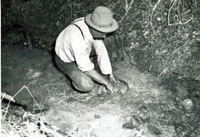
|
| Panning for gold in a mountain stream (Photo courtesy of the Georgia Department of Archives & History) |
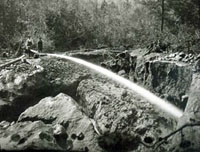
|
| Washing down the hillsides with a water cannon |
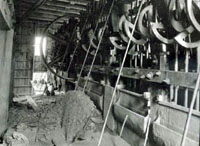
|
| An abandoned stamp mill. |
This new style of mining required considerable capital, so by the late 1850s, much of the mining property in north Georgia was owned by northern investors. Despite its name, the Southern Gold Company was incorporated under the laws of the State of New York. According to the company's Prospectus, published in May of 1859, their capital stock was divided into 100,000 shares of the par value of $5.00 each, with the right to increase to 200,000 additional shares.
The Prospectus noted that contracts had already been made for the immediate erection of a "Stamping Mill" and all other necessary machinery required to put the works into practical operation; also to bring water at a distance of some miles to sluice-wash, "that being the California process, and is the same just commenced by the Georgia Gold Company on their Lot adjoining this tract." The Prospectus also noted that "Experienced miners have been obtained from California and are now employed....to superintend the works which the Company expect to have in full operation within ninety days."
The mineral property of the Southern Gold Company was a tract of land, "one-fourth of a mile square," located "within the distance of two miles of the United States Mint, at Dahlonega, Lumpkin County, in the State of Georgia." This lot (#792) was originally known as the "Singleton or Capp's Lot" and was situated south of town on "a never-failing stream of water called 'Cane's Creek.'" The Prospectus included a report of the property's past history and future potential given by Mining Geologist and Engineer William P. Blake.
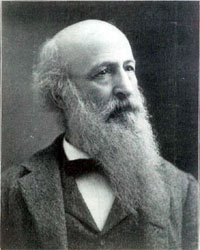
|
| George Augustus Gordon (Photo courtesy of Marian Otis, great granddaughter of George A. Gordon). |
A letter from the Office of the Southern Gold Company in Boston, Massachusetts, to Mr. George A. Gordon dated August 29, 1860, said: "This is to inform you that the Southern Gold Company has appointed you Superintendent of their Mining property, situated in the vicinity of Dahlonega.....The Company wish you to proceed forthwith to the Mines and take charge of the mining operations there and prosecute them with vigor....(and) the strictest economy. The gold which you may obtain, you will take to the U. S. Mint at Dahlonega, have it there assayed & converted into bars or ingots, or into Eagles or double Eagles, as you may find most expedient & economical, and forward the same at short intervals.....by Adams & Co's Exports, to the Treasurer at Boston. A statement of your expenses & of the gold obtained, addressed to the Treasurer, is desired from you weekly, and a full & perfect account at the close of each month."
Although inexperienced in gold mining, 33-year-old George A. Gordon was apparently a very capable man with degrees in Civil Engineering from Dartmouth College. Under different circumstances he might have made the mines belonging to the Southern Company quite profitable, but he was overcome by events. A letter written to him from another one of the proprietors on October 29, 1860, noted: "In regard to the Bowler W. Field mine, I would say that the entire stock market here is in such a depressed state that it is impossible to sell anything for its value. The prospect of Lincoln's election seems to paralyze everyone & no one can tell where it will end. The depreciation in every thing is fearful & everyone holds off & declines all risks however flattering. I hope soon to hear good news from the Southern."
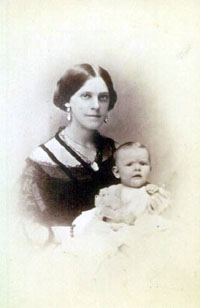
|
| Ann Farley Gordon with one of her children (photo courtesy of Marian Otis, great granddaughter of George and Ann Gordon). |
When Georgia seceded from the Union on January 19, 1861, the Southern Company took steps to reorganize its mining property under a Georgia Charter "should peaceable relations be disturbed and war ensue and the belligerent measure of confiscation of the property of Northerners be put in force." On February 21, George W. Gordon sent his nephew a Quit Claim deed placing his undivided fifth interest of the Dahlonega mining property in George A. Gordon's name, "thus securing my interest in the name of a Georgia(n)." In another letter written on August 21, he wrote, "I am about as good a Rebel as you are, the other proprietors are not so, and are mad . Some of them are not disposed to do anything to protect their interest, say the property is good for nothing, any how, let the secessionists have it, etc."
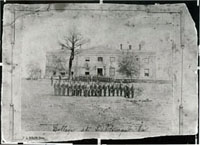
|
| The only known photograph of the United States Branch Mint at Dahlonega after it became North Georgia Agricultural College in 1873. The building burned in 1878. |
As more and more miners dropped their picks and shovels to shoulder Confederate (and sometimes Union) rifles, Dahlonega's gold mines were left unmanned. With no local work to supervise, George Gordon went to North Carolina where he found employment at some gold mines still in operation in 1862. His wife Ann remained in Dahlonega with their two children, Agnes and Lysson, who was born in Dahlonega on November 5, 1861. Ann's older sister Caroline lived with them.
Apparently gold mining also came to a halt in North Carolina as the war wore on, for George returned to Dahlonega. He was undoubtedly concerned about his family because marauding bands of Confederate deserters and Union sympathizers were making raids on the civilian population in north Georgia, looting and burning homes and even murdering the inhabitants.
When Governor Joseph E. Brown was informed that a large band of armed outlaws was marching against Dahlonega in January of 1863, the governor sent Georgia State Line troops to defend the town and arrest the insurgents. While in Dahlonega, Capt. E. M. Galt recruited a number of local men to form Company D of the 1st Regiment of the Georgia State Troops, popularly known as the "Blue Ridge Rangers." George A. Gordon enlisted as a private, but was appointed lieutenant and assistant quartermaster of the regiment on April 4, 1863. His military enlistment could have been an attempt to avoid having the Southern Company's mining property confiscated by the Confederacy, but it also reflected George's strong political views favoring States' Rights. For the next two years he served his unit so well that he was promoted to captain in April of 1865 and appointed "Assistant Quarter Master in the service of the State of Georgia."
Although mail was cut off between North and South, making it impossible for the Gordons to communicate with their relatives in Massachusetts during the war years, mail lines still ran within the Confederacy, so that George and Ann were able to exchange letters regularly. George was highly observant and skilled in verbalizing his perceptions and expressing his views. His letters are very interesting for their commentaries on military movements and actions, including the Battle of Atlanta. However, their content is beyond the scope of this article. (For further information about the Gordon Civil War letters, contact Al Adams at aladams@goldrushgallery.com)
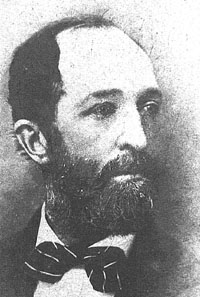
|
| Amory Dexter came to Dahlonega in 1859 as engineer for the Yahoola & Cane Creek Mining Company. |
One of Dexter's main tasks was the construction of the "Yahoola Ditch," an aqueduct that would convey water to the mines with adequate pressure to wash down the hillsides in search of gold beneath the surface. The aqueduct was a monumental engineering feat that cost the Yahoola Company huge expenses for leases, labor, and materials. Although the dam was only seven miles from Dahlonega as the crow flies, the ditch more than doubled the distance in the process of following the curving contours of the mountainous terrain in order to maintain a constant rate of descent. Cuts had to be dug through hillsides, and trestles had to be erected to carry the flumes over ravines. An 1859 map shows two large trestles and five smaller ones.
The ditch had to be constantly monitored so that leaks and breaks could be repaired and obstructions such as tree limbs could be removed before the flow of water was seriously interrupted. Throughout the year 1861, Amory Dexter kept a daily pocket diary (on display at the Dahlonega Gold Museum) which recorded such entries as, "As it rained had last night, the water came through our ditch...." and "....found ditch dammed up with leaves in several places."
Dexter's diary is significant not only for its mining information but also for first-hand observations about the effects of the Civil War. On January 10, it noted "South Carolina is now out of the Union." and on January 11, "Mr. Hamilton left for the Georgia Convention," followed by a terse entry on January 19, noting "Georgia gone out of Union."
On May 3, Dexter wrote: "Walter B. Smith left last night for the north & several parties levied attachments on his property today." After receiving news of his father's death on May 4, Dexter left Dahlonega headed for Boston and arrived in Marietta planning to catch the train that evening. However, he changed his mind at the last minute, perhaps concerned that the Yahoola property might be seized in his absence or that he might not be able to return to the South.
Dexter's June 6 entry recorded two disturbing turns of events: "Mint closed 1st June" and "U. S. Mail stopped June 1st." On June 15, he reported a "Large meeting in Town in relation to war" and on July 3: "Ladies making uniforms for the company going off." On July 6, he noted: "The Dahl. Volunteer Co. Blue Ridge Rifles left for Service under Capt. Hamilton."
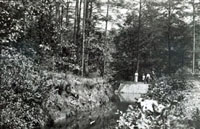
|
| A portion of the Yahoola Ditch (Photo courtesy of the Georgia Department of Archives & History). |
As the Union continued to fall apart, Dexter continued working to get his mill into operation and monitor the ditch. His succinct diary entries intersperse war reports with mining activities and daily activities, including having tea with the Dexters' friends, the Gordons. On occasion George Gordon joined his friend in walking the ditch.
Dexter was apparent not exempt from some military duty: On October 19, he wrote: "Morng., went to mill site - Out drilling with Militia in a company drill..." His October 27 diary entry noted: "Morng., went to mill site - on return found the Tax Assessor for Confederate Tax receiving the amounts. I returned company and other taxes."
There was some good news recorded on November 14: ".....we got the mill running for the first time - had eight stamps at work." Lacking funding due to mail service being cut off between him and company headquarters in Boston, Dexter was undoubtedly hoping to recover enough gold from the mill to cover his operating expenses and pay the taxes.
As more and more local men went off to war, Dexter went from lacking funds to pay workers to being unable to find able-bodied men to work. On December 9th, Dexter reported "no one at work this week" at the mine or the mill. Most of his time was spent working on his accounts, but he continued to walk the ditch to monitor the flow of water.
The beginning of the end is duly noted in his December 3 entry: "Sale Day - Sheriff's sale at 11: a.m.....The Yahoola and Woods' mines were advertized for taxes. I had Yahoola postponed for 30 days." The 30-day grace period for paying taxes on the Yahoola Company passed, but Dexter did not record in his diary whether or not he was able to come up with the money to pay the overdue taxes. However, legal proceedings that took place before the Superior Court of Lumpkin County in February of 1862 barred Amory Dexter from continuing to act as agent for the Yahoola Company. On January 22, he noted "Rec'd. an offer to go to Brunsk as clerk & decided to accept." The final entries in his diary were written on January 27: "Left Dahlonega with wife by private conveyance for Brunswick via Cumming" and January 28: "Took stage to Marietta."
The Dexters and the Gordons stayed in touch by letter during the war years, and Kate Dexter returned to Dahlonega on one occasion to check on their property and possessions that they had left behind. She also wrote frequent lengthy letters to Ann Gordon asking her to take care of various matters for her.
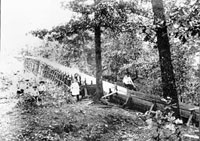
|
| After the Civil War, high trestles were replaced with iron or wooden tubes (photo courtesy of Enoch Hicks). |
By the time the war ended in 1865, Dexter's ditch had sprung countless leaks, and flumes and trestles had rotted away. The Dexters returned to the North, and Frank W. Hall was sent to Dahlonega in 1868 as superintendent of mining and milling for the Yahoola River & Cane Creek Hydraulic Hose Mining Company. Rather than rebuild the two largest trestles, 23-year-old Hall piped the water down the steep hillsides through iron tubes, using the force of gravity to carry the water up the tube on the opposite side.
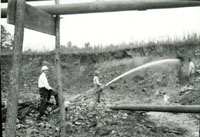
|
| Hydraulic mining (Photo courtesy of the Georgia Department of Archives & History). |
Although the Yahoola Company attempted to recover its losses, it apparently lacked the capital to complete the needed repairs. Its remaining assets were seized by order of the Federal District Court in Atlanta and sold to satisfy debts. However, the successful bidder at the August 1873 sale of the property was an officer of the Yahoola Company named Nathan H. Hand, who repaired and extended the Yahoola Ditch. Renamed the Hand Ditch, the aqueduct continued to supply water for hydraulic mining until after the turn of the century, but as interesting as it is, that story is beyond the scope of this article.
George and Ann Gordon and their by-this-time three children returned to Massachusetts in the fall of 1865. The Southern Gold Mining Company was apparently defunct, and no work was done on the mining property from the beginning of the Civil War until 1892. According to the 1896 A Preliminary Report on a part of the Gold Deposits of Georgia by State Geologist W. S. Yeates, the property was owned at that time by "Mr. Geo. A. Gordon, of Sommerville, Mass., whose representative in Dahlonega is Col. W. P. Price, of the law firm of Price and Charters." The Gordon mine and other mining property adjoining it which had belonged to the Southern Company eventually became part of the productive Barlow Mine, named for S. L. M. Barlow who bought it at sheriff's sale in 1871.
Although the Civil War brought gold mining in north Georgia to a virtual halt, activity resumed soon after peace was declared in 1865. Some local miners returning to the Dahlonega area resumed panning on their own, but most went to work for the large companies funded by Northern entrepreneurs.
The last large scale mining was done around the turn of the century by the Consolidated Gold Mining Company, which bought a number of local mines and erected what was reportedly the largest mill east of the Mississippi River. Due to over-speculation and other causes, this company was defunct by 1906. Mining continued on a small scale until 1942 when another war drove the final nail in the coffin of commercial gold mining in north Georgia.